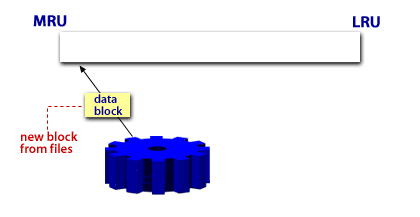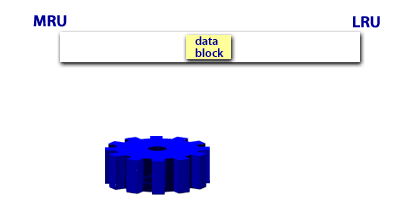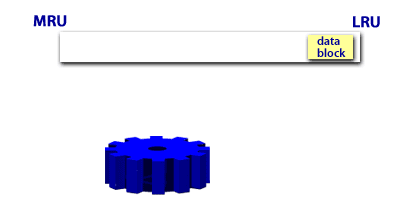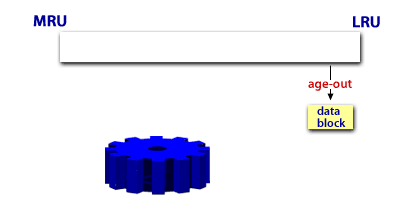| Lesson 3 | Calculate the data buffer hit ratio |
| Objective | Calculate the buffer hit ratio. |
Calculate Data Buffer Hit Ratio
As database blocks are retrieved from disk into the database, they are stored in RAM memory in a buffer. The block remains in the buffer until it is overwritten by another database request. At read time, the database first checks to see if the data already resides in the buffer before incurring the overhead of going to the disk. The following series of images below shows how datablocks that reside in the buffer are aged out after they are used.
Table Cache Directive in Oracle





Changes in Oracle Database 12c Release
Automatic Big Table Caching
This optional, configurable portion of the database buffer cache uses an algorithm for large tables based on object type and temperature. In single-instance and Oracle RAC databases, parallel queries can use the big table cache when the
DB_BIG_TABLE_CACHE_PERCENT_TARGETinitialization parameter is set to a nonzero value, and PARALLEL_DEGREE_POLICY is set to auto or adaptive. In a single-instance configuration only, serial queries can use the big table cache when DB_BIG_TABLE_CACHE_PERCENT_TARGET is set.
Buffer I/O
A logical I/O, also known as a buffer I/O, refers to reads and writes of buffers in the buffer cache. When a requested buffer is not found in memory, the database performs a physical I/O to copy the buffer from either the flash cache or disk into memory, and then a logical I/O to read the cached buffer.
Buffer Replacement Algorithms
To make buffer access efficient, the database must decide which buffers to cache in memory, and which to access from disk. The database uses the following algorithms:
The DB_BIG_TABLE_CACHE_PERCENT_TARGET initialization parameter sets the percentage of the buffer cache that uses this algorithm.
- LRU-based, block-level replacement algorithm: This sophisticated algorithm, which is the default, uses a least recently used (LRU) list that contains pointers to dirty and nondirty buffers. The LRU list has a hot end and cold end. A cold buffer is a buffer that has not been recently used. A hot buffer is frequently accessed and has been recently used. Conceptually, there is only one LRU, but for data concurrency the database actually uses several LRUs.
- Temperature-based, object-level replacement algorithm: Starting in Oracle Database 12c Release 1 (12.1.0.2), the automatic big table caching feature enables table scans to use a different algorithm in the following scenarios:
- Parallel queries: In single-instance and Oracle Real Applications Cluster (Oracle RAC) databases, parallel queries can use the big table cache when the DB_BIG_TABLE_CACHE_PERCENT_TARGET initialization parameter is set to a nonzero value, and PARALLEL_DEGREE_POLICY is set to auto or adaptive.
- Serial queries: In a single-instance configuration only, serial queries can use the big table cache when the DB_BIG_TABLE_CACHE_PERCENT_TARGET initialization parameter is set to a nonzero value.
The DB_BIG_TABLE_CACHE_PERCENT_TARGET initialization parameter sets the percentage of the buffer cache that uses this algorithm.
(FTS) Full-table Scan Data Blocks
Be aware the blocks read from a full-table scan are NOT loaded into the MRU end of the Oracle data buffer. Instead, full-table scan blocks are loaded into spaces on the LRU end of the Oracle data buffer, where they will age-out separately from blocks that are retrieved by means of indices. The Slide Shows below we see that (FTS) full-table scan data blocks are placed into the LRU side of the data buffer, and age-out faster than other data blocks.
Non Full Table Scan Data Block
Calculating the Buffer Cache Hit Ratio
The buffer cache hit ratio calculates how often a requested block has been found in the buffer cache without requiring disk access. This ratio is computed using data selected from the V$SYSSTAT performance view. Use the buffer cache hit ratio to verify the physical I/O as predicted by the V$DB_CACHE_ADVICE view.
Table 4-3 lists the statistics from the V$SYSSTAT view used to calculate the buffer cache hit ratio.

Example 4-3 shows a query of this view.
Example 4-3 Querying the V$SYSSTAT View
SELECT name, value
FROM V$SYSSTAT
WHERE name IN ('db block gets from cache', 'consistent gets from cache',
'physical reads cache');